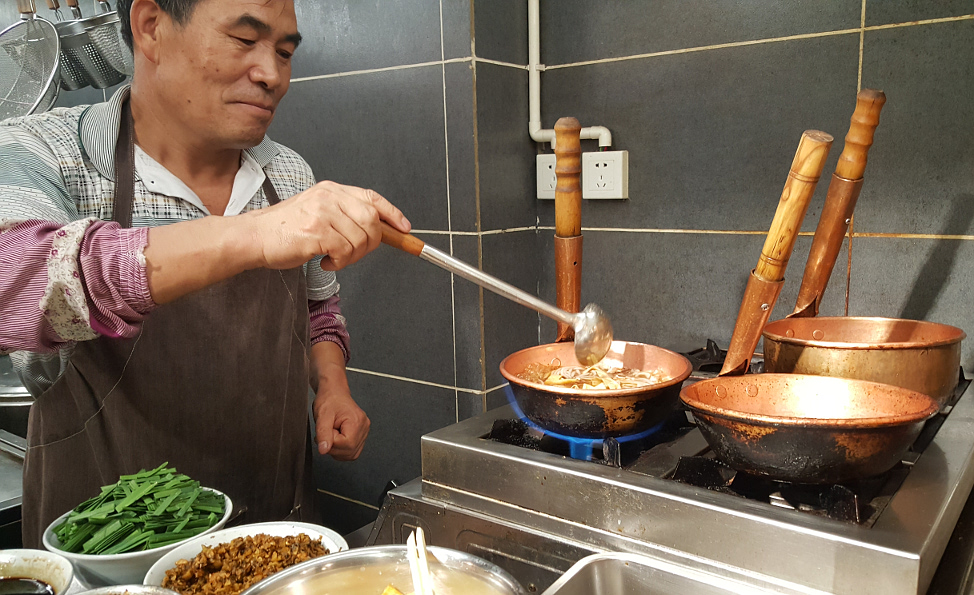|
Migan
Migan () is a type of rice noodle from the Dai people, a Tai cultural group from Yunnan Province, China. It is made from ordinary non-glutinous rice, and it is only sold fresh. Difference from other noodles Unlike the circular '' mixian'', ''migan'' is primarily defined by its relatively broad and flat shape. It is somewhat less widely available than ''mixian'', even within Yunnan, though it is still common. ''Migan'' is both rice flour based and freshly prepared, which differentiates it from the transparent ''fensi'' noodles that are common throughout much of mainland China. Serving Migan is typically served either in broth (often a chicken based broth, and particularly commonly consumed in the morning, though still consumed all day) or stir fried (perhaps more common in the evening). As with mixian, when migan is served in broth it is common for a range of individual condiments to be presented for customers to add to their bowl themselves. Condiments typically include chilli ... [...More Info...] [...Related Items...] OR: [Wikipedia] [Google] [Baidu] |
Zhe'ergen
''Houttuynia cordata'', also known as fish mint, fish leaf, rainbow plant, chameleon plant, heart leaf, fish wort, or Chinese lizard tail, is one of two species in the genus ''Houttuynia'' (the other being ''H. emeiensis''). It is a flowering plant native to Southeast Asia. It grows in moist, shady locations. It was named after Martinus Houttuyn. Growth ''Houttuynia cordata'' is a herbaceous perennial plant that can grow to , spreading up to . The proximal part of the stem is trailing and produces adventitious roots, while the distal part of the stem grows vertically. The leaves are alternate, broadly heart-shaped, long and broad. Its flowers are greenish-yellow and borne on a terminal spike long with four to six large white basal bracts. It normally blooms in the summer. It is considered an invasive plant because of its ability to regrow rhizomes from any segment of its foliage. Cultivation ''Houttuynia cordata'' grows in moist to wet soil or slightly submerged in ... [...More Info...] [...Related Items...] OR: [Wikipedia] [Google] [Baidu] |
Mixian (noodle)
''Mixian'' () is a type of rice noodle from the Yunnan Province, China. It is made from ordinary non- glutinous rice, and it is generally sold fresh rather than dried. Production The processing of ''mixian'' in Yunnan is unique, involving a fermentation process. In many areas there are at least two distinct thicknesses produced, a thinner form (roughly in diameter) and a thicker form (roughly in diameter). Serving ''Mixian'' is served in various ways, either in broth or stir-fried. Stir-fried Stir-fried preparation is rapid, most common in the evening, and is popular at roadside barbecue-type stands throughout Yunnan. Egg, tomato, meat, spring onion and chilli are frequently utilized. Broth The most famous prepared dish is '' guoqiao mixian'' (; literally 'crossing the bridge noodles'). More normally, when ''mixian'' is served in broth in Yunnanese restaurants, it is an extremely popular breakfast and day-time dish. Broths are generally chicken or beef, though others e ... [...More Info...] [...Related Items...] OR: [Wikipedia] [Google] [Baidu] |
China
China, officially the People's Republic of China (PRC), is a country in East Asia. It is the world's List of countries and dependencies by population, most populous country, with a Population of China, population exceeding 1.4 billion, slightly ahead of India. China spans the equivalent of five time zones and Borders of China, borders fourteen countries by land, the List of countries and territories by land borders, most of any country in the world, tied with Russia. Covering an area of approximately , it is the world's third List of countries and dependencies by area, largest country by total land area. The country consists of 22 provinces of China, provinces, five autonomous regions of China, autonomous regions, four direct-administered municipalities of China, municipalities, and two special administrative regions of China, Special Administrative Regions (Hong Kong and Macau). The national capital is Beijing, and the List of cities in China by population, most populous cit ... [...More Info...] [...Related Items...] OR: [Wikipedia] [Google] [Baidu] |
Coriander
Coriander (;coriander in the Cambridge English Pronouncing Dictionary ''Coriandrum sativum'') is an annual in the family Apiaceae. It is also known as Chinese parsley, dhania, or cilantro (). [...More Info...] [...Related Items...] OR: [Wikipedia] [Google] [Baidu] |
Yunnan Cuisine
Yunnan cuisine, alternatively known as Dian cuisine, is an amalgam of the cuisines of the Han Chinese and other ethnic minority groups in Yunnan Province in southwestern China. As the province with the largest number of ethnic minority groups, Yunnan cuisine is vastly varied, and it is difficult to make generalisations. Many Yunnan dishes are quite spicy, and mushrooms are featured prominently. Flowers, ferns, algae and insects may also be eaten. The cuisine of Yunnan is often compared to the cuisine of Southeast Asia as the province borders the region and many of the ethnic minorities or related cultural groups also have a presence in Southeast Asia. Three of the province's most famous products are the renowned Pu'er tea, which was traditionally grown in Ning'er; Xuanwei ham, which is often used to flavour stewed and braised foods in Chinese cuisine and for making the stocks and broths of many Chinese soups; and ''guoqiao'' (crossing the bridge), a rice noodle soup with c ... [...More Info...] [...Related Items...] OR: [Wikipedia] [Google] [Baidu] |
Rice
Rice is the seed of the grass species '' Oryza sativa'' (Asian rice) or less commonly '' Oryza glaberrima'' (African rice). The name wild rice is usually used for species of the genera '' Zizania'' and ''Porteresia'', both wild and domesticated, although the term may also be used for primitive or uncultivated varieties of '' Oryza''. As a cereal grain, domesticated rice is the most widely consumed staple food for over half of the world's human population,Abstract, "Rice feeds more than half the world's population." especially in Asia and Africa. It is the agricultural commodity with the third-highest worldwide production, after sugarcane and maize. Since sizable portions of sugarcane and maize crops are used for purposes other than human consumption, rice is the most important food crop with regard to human nutrition and caloric intake, providing more than one-fifth of the calories consumed worldwide by humans. There are many varieties of rice and culinary preferences t ... [...More Info...] [...Related Items...] OR: [Wikipedia] [Google] [Baidu] |
Vinegar
Vinegar is an aqueous solution of acetic acid and trace compounds that may include flavorings. Vinegar typically contains 5–8% acetic acid by volume. Usually, the acetic acid is produced by a double fermentation, converting simple sugars to ethanol using yeast, and ethanol to acetic acid by acetic acid bacteria. Many types of vinegar are available, depending on source materials. It is now mainly used in the culinary arts as a flavorful, acidic cooking ingredient, or in pickling. Various types are used as condiments or garnishes, including balsamic vinegar and malt vinegar. As the most easily manufactured mild acid, it has a wide variety of industrial and domestic uses, including use as a household cleaner. Etymology The word "vinegar" arrived in Middle English from Old French (''vyn egre''; sour wine), which in turn derives from Latin: ''vinum'' (wine) + ''acer'' (sour). Chemistry The conversion of ethanol (CH3CH2OH) and oxygen (O2) to acetic acid (CH3COOH) takes ... [...More Info...] [...Related Items...] OR: [Wikipedia] [Google] [Baidu] |
Tomato
The tomato is the edible berry of the plant ''Solanum lycopersicum'', commonly known as the tomato plant. The species originated in western South America, Mexico, and Central America. The Mexican Nahuatl word gave rise to the Spanish word , from which the English word ''tomato'' derived. Its domestication and use as a cultivated food may have originated with the indigenous peoples of Mexico. The Aztecs used tomatoes in their cooking at the time of the Spanish conquest of the Aztec Empire, and after the Spanish encountered the tomato for the first time after their contact with the Aztecs, they brought the plant to Europe, in a widespread transfer of plants known as the Columbian exchange. From there, the tomato was introduced to other parts of the European-colonized world during the 16th century. Tomatoes are a significant source of umami flavor. They are consumed in diverse ways: raw or cooked, and in many dishes, sauces, salads, and drinks. While tomatoes are fruitsâ ... [...More Info...] [...Related Items...] OR: [Wikipedia] [Google] [Baidu] |
Soy Sauce
Soy sauce (also called simply soy in American English and soya sauce in British English) is a liquid condiment of Chinese origin, traditionally made from a fermented paste of soybeans, roasted grain, brine, and '' Aspergillus oryzae'' or '' Aspergillus sojae'' molds. It is considered to contain a strong umami taste. Soy sauce in its current form was created about 2,200 years ago during the Western Han dynasty of ancient China, and it has spread throughout East and Southeast Asia where it is used in cooking and as a condiment. Use and storage Soy sauce can be added directly to food, and is used as a dip or salt flavor in cooking. It is often eaten with rice, noodles, and sushi or sashimi, or can also be mixed with ground wasabi for dipping. Bottles of soy sauce for salty seasoning of various foods are common on restaurant tables in many countries. Soy sauce can be stored at room temperature. History East Asia China Soy sauce (, ) is considered almost as ... [...More Info...] [...Related Items...] OR: [Wikipedia] [Google] [Baidu] |
Spring Onion
Scallions (also known as spring onions or green onions) are vegetables derived from various species in the genus ''Allium''. Scallions generally have a milder taste than most onions and their close relatives include garlic, shallot, leek, chive, and Chinese onions. Although the bulbs of many ''Allium'' species are used as food, the defining characteristic of scallion species is that they lack a fully developed bulb. Instead the ''Allium'' species referred to as scallions make use of the hollow, tubular green leaves growing directly from the bulb. These leaves are used as a vegetable and can be eaten either raw or cooked. Often the leaves are chopped into other dishes and used as garnishes. Etymology and names The words ''scallion'' and ''shallot'' are related and can be traced back to the Ancient Greek () as described by the Greek writer Theophrastus. This name, in turn, is believed to originate from the name of the ancient Canaanite city of Ashkelon. Various other names ... [...More Info...] [...Related Items...] OR: [Wikipedia] [Google] [Baidu] |
Salt
Salt is a mineral composed primarily of sodium chloride (NaCl), a chemical compound belonging to the larger class of salts; salt in the form of a natural crystalline mineral is known as rock salt or halite. Salt is present in vast quantities in seawater. The open ocean has about of solids per liter of sea water, a salinity of 3.5%. Salt is essential for life in general, and saltiness is one of the basic human tastes. Salt is one of the oldest and most ubiquitous food seasonings, and is known to uniformly improve the taste perception of food, including otherwise unpalatable food. Salting, brining, and pickling are also ancient and important methods of food preservation. Some of the earliest evidence of salt processing dates to around 6,000 BC, when people living in the area of present-day Romania boiled spring water to extract salts; a salt-works in China dates to approximately the same period. Salt was also prized by the ancient Hebrews, Greeks, Romans, Byza ... [...More Info...] [...Related Items...] OR: [Wikipedia] [Google] [Baidu] |







